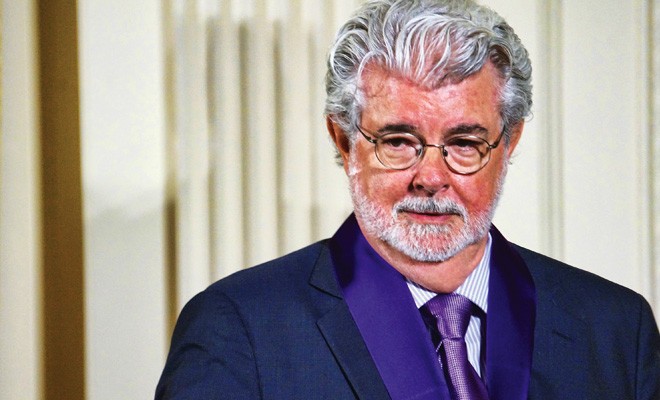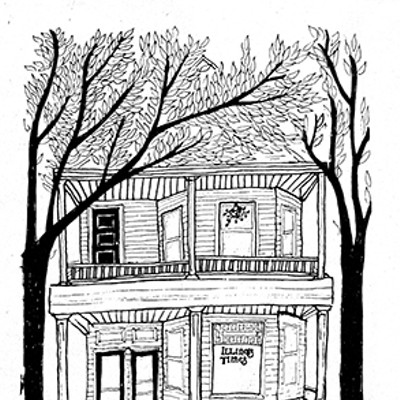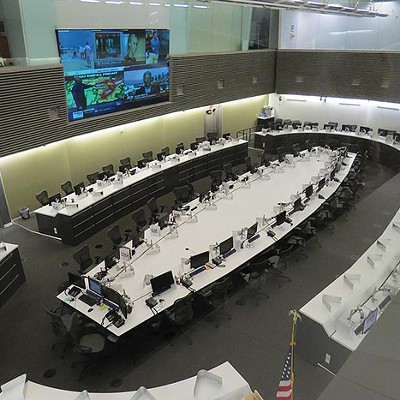Cultural arts major
George Lucas wants to improve young Chicagoans
[
{
"name": "Air - MedRect Combo - Inline Content 1",
"component": "11490391",
"insertPoint": "3",
"requiredCountToDisplay": "1",
"parentWrapperClass": "fdn-ads-inline-content-block"
},{
"name": "Air - MedRect Combo - Inline Content 2",
"component": "11490392",
"insertPoint": "7",
"requiredCountToDisplay": "5",
"parentWrapperClass": "fdn-ads-inline-content-block"
},{
"name": "Air - MedRect Combo - Inline Content 3",
"component": "11490393",
"insertPoint": "12",
"requiredCountToDisplay": "9",
"parentWrapperClass": "fdn-ads-inline-content-block"
}
]
Toymaker George Lucas is thinking about buying Chicago a museum to house his personal collection of early 20th century soft-core and magazine cover art by the likes of Maxfield Parrish and Norman Rockwell, among exhibits devoted to cartooning and movie graphics. The Florentines had the Medici, we have the Spielbergs, the Jobses, the Lucases.
The Lucas museum will feature the technology behind Toy Story, the sound effects that “created” the light saber (surely they “suggested”) and similar wonders of gimcrackery from DreamWorks Animation SKG, the maker of Shrek and Pixar, the creator of the Toy Story franchise. Chicago officials are thrilled at the prospect of attracting even more tourists to tax and have given Lucas a key to the city, if not (yet) to the city treasury.
The new museum promises (if that is the word) such wonders as a scale model of Han Solo’s Millennium Falcon from the eternal Star Wars saga. Twelve-year-old boys of all ages will be delighted, but the rest of us? Models of real wonders can instruct and delight – think of Colleen Moore’s doll house at the Museum of Science and Industry or the Thorne Miniature Rooms at the Art Institute – but models of models?
It would hardly seem to matter whether Illinois’ great city, which suffers with a second-class transit system and a second-class school system, gets a second-class museum. Nor are Lucas’s pretensions any more pretentious than those of a lot of self-made billionaires. (Lucas is to the arts what Donald Trump is to politics.) The project has left me peeved nonetheless. If he plainly labeled his collection as popular art, or identified his museum’s focus as pop culture, us snobs would have no beef with him; our popular culture is our gift to the world, and it is not George Lucas’ fault that pop culture is the only culture we have.
But no, his museum is to be devoted to the “cultural arts.” The phrase is gibberish of the sort that only a deeply uncultured man is capable of. Vanity projects of this sort always get wrapped in the rhetoric of high public purpose – they never do it for the attention or the tax deductions, do they? – but one should always peek under the wrapper when billionaires begin talking, as Lucas has done, about wanting to building his museum “someplace where it will add to the educational benefit of young people.” If that were the criterion he’d put it in his home town of Modesto, whose young people can use all the benefit they can get.
Of course, if rich men did not give Chicago museums, Chicago would have no museums. (To learn more, read Culture and the City: Cultural Philanthropy in Chicago from the 1880s to 1917, by Helen Lefkowitz Horowitz.) Most of these benefactors had tastes every bit as plebeian as Lucas’s, who, like them, is a self-made man. The George Lucas of his day was Julius Rosenwald (a Springfield boy, remember) who was most responsible for turning the Palace of Fine Arts from the 1983 world’s fair into the Museum of Science and Industry, where entertainment technology was harnessed to the wagon of corporate propaganda.
And let us not forget Daniel Terra. There is no patriot more gaudily grateful than an immigrant who’s made it, and Terra made it big in printing inks and chemicals. He was a political naif who conflated his rise with that of America, and bought American art that affirmed its myths. He was no Lucas; he bought many decent works – more than 700 paintings, prints, drawings, photographs and sculpture, the best of which are now on “long-term” loan to the Art Institute. (He crammed his collection into the Terra Museum of American Art, which for a while gave tourists something other than the shopping rich to gawk at on N. Michigan Ave.; Terra dressed up as Uncle Sam and sang “I’m a Yankee Doodle Dandy” when it opened in 1987.) Chauvinism is no more attractive in art than in politics, and Terra didn’t always bother to keep them straight; his collection contains many first-class examples of second-class painting, and the museum closed.
I should add that museums were not all that Chicago’s rich have given the city. Rosenwald also donated millions to public schools (including schools for African-American children in the South that never had schools before), colleges and universities, assorted Jewish charities and YMCAs in poor neighborhoods. Meatpacker Phillip D. Armour spent his money on a manual training school for the ambitious children of the working class and poor that became the Illinois Institute of Technology. Marshall Field endowed the natural history museum that bears his name, one of the world’s great research institutions. If Lucas really wants to invest his money to add to the educational benefit of young people, there are better ways to do it.
Contact James Krohe Jr. at [email protected].
The Lucas museum will feature the technology behind Toy Story, the sound effects that “created” the light saber (surely they “suggested”) and similar wonders of gimcrackery from DreamWorks Animation SKG, the maker of Shrek and Pixar, the creator of the Toy Story franchise. Chicago officials are thrilled at the prospect of attracting even more tourists to tax and have given Lucas a key to the city, if not (yet) to the city treasury.
The new museum promises (if that is the word) such wonders as a scale model of Han Solo’s Millennium Falcon from the eternal Star Wars saga. Twelve-year-old boys of all ages will be delighted, but the rest of us? Models of real wonders can instruct and delight – think of Colleen Moore’s doll house at the Museum of Science and Industry or the Thorne Miniature Rooms at the Art Institute – but models of models?
It would hardly seem to matter whether Illinois’ great city, which suffers with a second-class transit system and a second-class school system, gets a second-class museum. Nor are Lucas’s pretensions any more pretentious than those of a lot of self-made billionaires. (Lucas is to the arts what Donald Trump is to politics.) The project has left me peeved nonetheless. If he plainly labeled his collection as popular art, or identified his museum’s focus as pop culture, us snobs would have no beef with him; our popular culture is our gift to the world, and it is not George Lucas’ fault that pop culture is the only culture we have.
But no, his museum is to be devoted to the “cultural arts.” The phrase is gibberish of the sort that only a deeply uncultured man is capable of. Vanity projects of this sort always get wrapped in the rhetoric of high public purpose – they never do it for the attention or the tax deductions, do they? – but one should always peek under the wrapper when billionaires begin talking, as Lucas has done, about wanting to building his museum “someplace where it will add to the educational benefit of young people.” If that were the criterion he’d put it in his home town of Modesto, whose young people can use all the benefit they can get.
Of course, if rich men did not give Chicago museums, Chicago would have no museums. (To learn more, read Culture and the City: Cultural Philanthropy in Chicago from the 1880s to 1917, by Helen Lefkowitz Horowitz.) Most of these benefactors had tastes every bit as plebeian as Lucas’s, who, like them, is a self-made man. The George Lucas of his day was Julius Rosenwald (a Springfield boy, remember) who was most responsible for turning the Palace of Fine Arts from the 1983 world’s fair into the Museum of Science and Industry, where entertainment technology was harnessed to the wagon of corporate propaganda.
And let us not forget Daniel Terra. There is no patriot more gaudily grateful than an immigrant who’s made it, and Terra made it big in printing inks and chemicals. He was a political naif who conflated his rise with that of America, and bought American art that affirmed its myths. He was no Lucas; he bought many decent works – more than 700 paintings, prints, drawings, photographs and sculpture, the best of which are now on “long-term” loan to the Art Institute. (He crammed his collection into the Terra Museum of American Art, which for a while gave tourists something other than the shopping rich to gawk at on N. Michigan Ave.; Terra dressed up as Uncle Sam and sang “I’m a Yankee Doodle Dandy” when it opened in 1987.) Chauvinism is no more attractive in art than in politics, and Terra didn’t always bother to keep them straight; his collection contains many first-class examples of second-class painting, and the museum closed.
I should add that museums were not all that Chicago’s rich have given the city. Rosenwald also donated millions to public schools (including schools for African-American children in the South that never had schools before), colleges and universities, assorted Jewish charities and YMCAs in poor neighborhoods. Meatpacker Phillip D. Armour spent his money on a manual training school for the ambitious children of the working class and poor that became the Illinois Institute of Technology. Marshall Field endowed the natural history museum that bears his name, one of the world’s great research institutions. If Lucas really wants to invest his money to add to the educational benefit of young people, there are better ways to do it.
Contact James Krohe Jr. at [email protected].
Illinois Times has provided readers with independent journalism for almost 50 years, from news and politics to arts and culture.
Your support will help cover the costs of editorial content published each week. Without local news organizations, we would be less informed about the issues that affect our community..
Got something to say?
Send a letter to the editor and we'll publish your feedback in print!





















